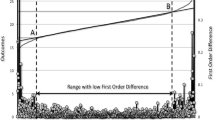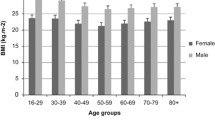Abstract
Background and aims
Statistical quality control charts (SQCCs) have been widely used in numerous manufacturing processes to keep fluctuations within the acceptable limits but no applications have been applied to weight management studies yet. The aims of the present study were (1) to show that using the mean Body Mass Index (BMI) values as the only indicator to assess the weight status of populations might be misleading in clinical weight management studies; and (2) to introduce a powerful tool, SQCCs, to keep fluctuations in BMIs within acceptable limits in a given population for healthy aging.
Methods
The study design was cross-sectional. The distributions of individual BMIs (n=829) between specified limits (USL=24.9 and LSL=18.5) and the pattern of BMI change by age were studied using X-charts, tolerance charts and a capability analysis.
Results
The mean BMI increased in both genders by age. In some groups, although a significant number of people were outside the normal weight BMI limits the mean BMI values were within the normal limits (18.5<BMI < 24.9). In addition, although the number of overweight individuals was greater in some groups, their mean BMIs were lower compared to the groups with fewer overweight individuals. Capability tests clearly show that each group, even the groups with a mean BMI in the normal weight ranges and also the groups which are referred as being “under control” according to the X-charts, was not in energy balance (Cp<l and Cpk<l).
Conclusion
The results clearly indicate that using the mean BMIs as the only indicator might be misleading in weight management studies. This study introduces SQCCs as a potential tool for clinical nutrition studies to maintain the fluctuations of individual BMIs within acceptable limits for healthy aging populations
Similar content being viewed by others
References
United Nations Programme on aging. http://www.un.org/ageing/stakeholders_worldbank.html (Accessed 10. 11.2009)
Bobroff L. Elder nutrition. Aging in the 21th Century. 2003, http://edis.ifas.ufl.edu/pdffiles/fy/fy62800.pdf (Accessed 10.11.2009)
World Health Organization Global InfoBase. 〈http://www.who.int〉 (Accessed 13.12.2008).
Besterfield DH. Quality Control. Seventh Edition, Pearson Educ, 2004, pp 173–233.
Özilgen M. Food Process Modeling and Control Chemical Engineering Applications. Gordon and Breach, 1998, pp 385–437.
Benneyan JC. Use and interpretation of statistical quality control charts. International Journal for Quality in Health Care 1998;10(1):69–73.
Srikaeo K, Furst JE, Ashton J. Characterization of wheat-based biscuit cooking process by statistical quality control techniques. Food Control; 2005 16:309–317.
Pfadt A, Wheeler DJ. Using statistical process control to make data-based clinical decisions. Journal of Applied Behavior Analysis 1995; 28:349–370.
Schnelle JF, Newman DR. Statistical quality control in nursing homes: Assessment and management of chronic urinary incontinence. Health Service Research 1990; 25(4):627–637.
Jamali AS, JinLin L, Keerio MU, Rajpar A. Performance measure of Shewhart control chart for armature resistance process. Information Technology Journal 2007; 6(4):573–578.
Stamatis DH (2004) Six Sigma Fundamentals-A complete guide to the system, methods and tools. Productivity, New York
USDA United States Department of Agriculture http://www.mypyramid.gov/pyramid/ (Accessed 10.11.2009)
Kuczmarski MF, Kuczmarski RJ and Najjar M. Effects of Age on Validity of Self-Reported Height, Weight, and Body Mass Index: Findings from the Third National Health and Nutrition Examination Survey, 1988–1994. J Am Diet Assoc. 2001; 101(1):28–34.
Interpretation of BMI for adults http://www.cdc.gov/healthyweight/assessing/bmi/adult_bmi/ (Accessed 10. 11.2009).
Rurik I, Sandholzer H, Kalabay. Does the dynamicity of weight gain predict elements of metabolic syndrome? Differences in weight gain in hypertensive, diabetic, and obese elderly patients: A pilot study in primary care. Med Sci Monit 2009: 15(2) 40–44
The BMI gap between men and women, http://www.halls.md/bmi/gap.htm (Accessed 10. 11.2009).
Middle age weight gain: men unlikely to outrun it. http://www.Ibl.gov/Science-Articles/Archive/spare-tire.html (Accessed 10.11.2009).
Panotopoulos G, Raison J, Ruiz JC, Guy-Grand B, Basdevant A. Weight gain at the menopause. Europian Society for Human Reproduction and Embryology 1997; 12: 126–133.
Bonithon-Kopp C, Raison J, Courbon G. Relationship between 3-year longitudinal changes in body mass index, waist to hip ratio and metabolic variables in active French female population. Am. J. Clinical Nutrition 1992; (56) 475–482.
Garry PJ, Wayne, SJ, Vellas B The New Mexico aging process study (1979–2003) A longitudinal study of nutrition, healthy and aging. J. Nutrition Health & Aging 2007: 125–130
Sammel MD, Grisso AJ, Freeman EW, Hollander L, Liu L, Liu S, Nelson DB, Battistini M. Weight gain among women in the late reproductive years. Family Practice 2003; 20(4):401–409.
Poehlman ET, Toth MJ, Gardner AW. Changes in energy balance and body composition at menopause: a controlled longitudinal study. Annals of Internal Medicine 1995; 123(9):673–675.
Frankenfield DC, Rowe AW, Cooney RN, Smith SJ, Becker D Limits of body mass index to detect obesity and predict body composition. Nutrition 2001; 17:26–30.
Ko GTC, Tang J, Chan NCJ, Sung R, Wu MMF, Wai HPS, Chen R Lower BMI cutoff value to define obesity in Hong Kong Chinese: an analysis based on body fat assessment by bioelectrical impedance. The British Journal of Nutrition 2001; 85(2):239–242.
Mascie-Taylor NCG, Goto R. Human variation and body mass index: A review of the universality of BMI cut-offs, gender and urban-rural differences, and secular changes. Journal of Physiological Anthropology 2007; 26: 109–111
Author information
Authors and Affiliations
Corresponding author
Rights and permissions
About this article
Cite this article
Ozilgen, S. Statistical quality control charts: New tools for studying the body mass index of populations from the young to the elderly. J Nutr Health Aging 15, 333–339 (2011). https://doi.org/10.1007/s12603-010-0290-8
Received:
Accepted:
Published:
Issue Date:
DOI: https://doi.org/10.1007/s12603-010-0290-8




